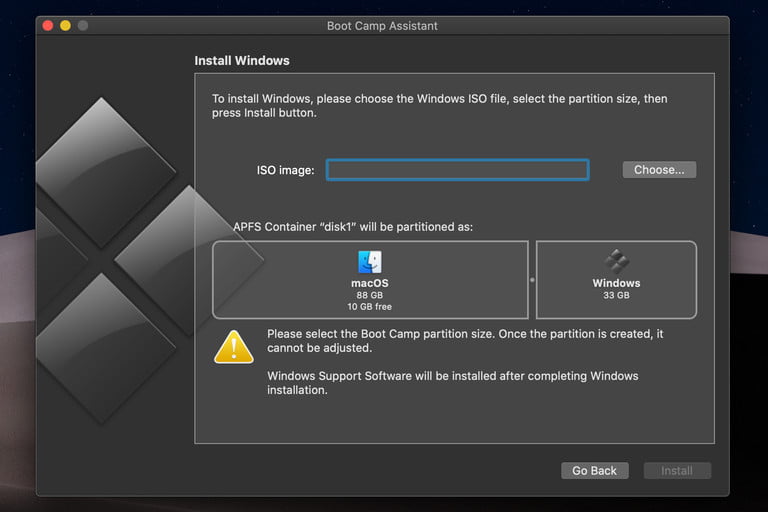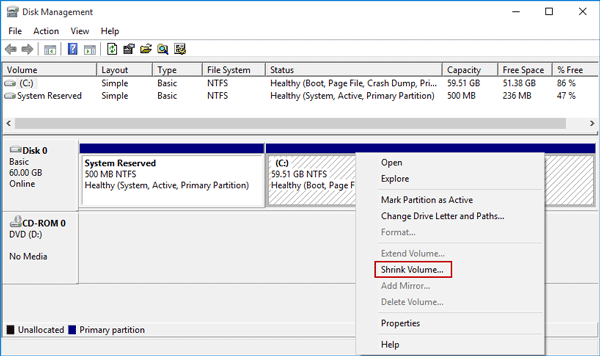

- #CREATE PARTITION FOR WINDOWS MAC OSX MAC OS X#
- #CREATE PARTITION FOR WINDOWS MAC OSX INSTALL#
- #CREATE PARTITION FOR WINDOWS MAC OSX UPDATE#
- #CREATE PARTITION FOR WINDOWS MAC OSX UPGRADE#
#CREATE PARTITION FOR WINDOWS MAC OSX INSTALL#
i do the change stated above is mainly because i thought that the main concept for the new bootcamp is that you don't need usb to install windows, and the partition created is for installing the windows, and it will be deleted after rebooting when you complete the install process.
#CREATE PARTITION FOR WINDOWS MAC OSX UPGRADE#
i install win 8.1 and upgrade to win 10 the first time, and i do a direct install of win 10 the second time.
#CREATE PARTITION FOR WINDOWS MAC OSX UPDATE#
i have install the update before restart the computer after installing the bootcamp driver in first time, but i immediately reboot the computer after installing the bootcamp driver in second trial.ģ. Boot Camp gives you the ability to make a Windows-bootable partition, making it easy to install Windows while maintaining a bootable macOS partition, too. i have plug in the empty usb stick in first time, but i remove it in the second try.Ģ. You can easily create a recovery drive using Windows 10s built-in tool. There are three main differences between this time and the failed on before, in case someone also come across this problem, for your reference.ġ. Firstly, defrag your drive and check to see that the end of the drive is free of files. Option 2: GPT with a single HFS+J partition for the OS X installer (hidden EFI. To know the complete process of creating Windows partition on Mac, continue reading the article. (in windows) did windows partitioning, all 3 partitions (no formatting) - rebooted to OS X 10.5.6 (Leopard) - did the command line instructions, formatted all 3 partitions as FAT32 with names of my choice - went to OS X Disk Utility, and the renamed partitions all showed up just fine. Third-party applications can enable write support for these partitions, while you can also share files in other ways. Thankfully, there are ways around these file-system limitations.
#CREATE PARTITION FOR WINDOWS MAC OSX MAC OS X#
When you Windows "attack" is finished - yes, you can remove Windows, and reinstall OS X.Thanks, i have try to use bootcamp to cancel the partition and do it all over again, and it finally can auto delete the osxreserved partition. Want to set up a Windows partition on your Mac Then, take the assistance of Boot Camp to create a Windows partition on Mac. Both Windows and Mac OS X can see each other’s files, but they can’t write to the other operating system’s partition. (Kind of an expensive Windows laptop, but if that's what you want. You don't need to save ANY part of the OS X system, if you don't want it. Android Extract the ISO files in the created 16 GB partition. Other than that, my bootcamp is the only os on the disk. Run Prime OS without using USB drive in Dual Boot Mode (Windows & Prime OS). disk and is used by management software such as the Windows registry The partition table. You can see in the image below that only 200 is needed by the internal mac os (to boot the mac and so forth). reserved, known as the boot block in UNIX/Linux and Mac OS X. Once the partition is made and windows is working, then you can delete osx and allocate the memory to windows. Step 3: Click 'Browse'' button to import macOS dmg file into the program.

Step 2: Insert your formatted USB drive, and click 'Burn' tab on the main screen. Once you have that support software saved, then you can boot to your Windows installer, erase your internal storage, and use the entire drive for your Windows system. You must first use bootcamp with osx to create the partition. Step 1: Right-click the software icon on desktop and select 'Run as Administrator' from the contextual menu. When you install Windows, the boot camp support software will install automatically, when you set up your Windows user.

Run the Boot Camp assistant, and choose from the Action menu to download the Windows Support softwareĮven better, if you have a USB flash drive with your Windows installer ISO, save the Windows Support download to that flash drive. NTFS: since it is the native file system for Windows, volumes created in NTFS are read and write with computers running Windows. If you need all the space on your internal drive for your Windows needs, then that's pretty easy.


 0 kommentar(er)
0 kommentar(er)
